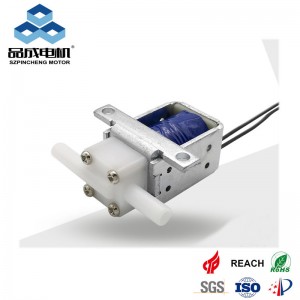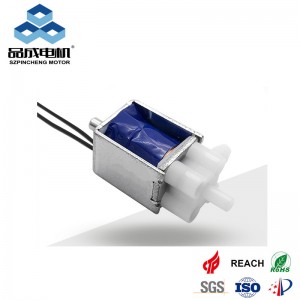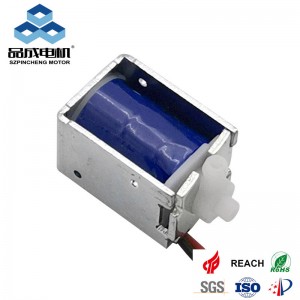Micro solenoid valves are critical components in industries ranging from medical devices to aerospace, where rapid and precise fluid control is essential. Their response time—the duration between receiving an electrical signal and completing the mechanical action—directly impacts system efficiency and reliability. This article explores cutting-edge strategies to enhance micro solenoid valve performance, supported by technical insights and real-world applications.
1. Material Innovations for Faster Magnetic Response
High-Permeability Soft Magnetic Materials
Traditional solenoid cores use iron-based alloys, but advancements in powder metallurgy (PM) have introduced high-performance alternatives. For example, iron-phosphorus (Fe-P) and iron-silicon (Fe-Si) alloys offer superior magnetic permeability and reduced hysteresis loss . These materials enable faster magnetization and demagnetization, cutting response times by up to 20% compared to conventional iron cores.
Nanotechnology-Driven Coatings
Nanocomposite coatings, such as diamond-like carbon (DLC) and nanocrystalline nickel-phosphorus (Ni-P), reduce friction between moving parts like the armature and valve body. A study by showed that nanocoatings decreased mechanical resistance by 40%, enabling smoother motion and shorter actuation times. Additionally, self-lubricating nanomaterials (e.g., tungsten disulfide) further minimize wear, ensuring consistent performance over millions of cycles.
Rare-Earth Magnets
Replacing traditional ferrite magnets with neodymium-iron-boron (NdFeB) magnets increases magnetic flux density by 30–50% . This enhancement reduces the time required to generate sufficient force to move the armature, particularly beneficial for high-pressure applications.
2. Design Optimization for Mechanical Efficiency
Miniaturized Core and Armature Geometry
Aerospace-grade designs, like those used in Marotta Controls’ MV602L valves, employ all-welded stainless steel construction with minimal moving parts . Reducing mass and inertia allows the armature to accelerate faster, achieving response times <10 milliseconds even in extreme environments.
Balanced Spring and Seal Mechanisms
Innovative designs, such as the balance spring and regulating screw in X Technology’s micro solenoid valves, compensate for manufacturing tolerances and ensure consistent spring force . This reduces variability in opening/closing times, critical for applications requiring repeatable performance (e.g., medical infusion pumps).
Magnetic Circuit Refinement
Optimizing the air gap between the core and armature minimizes magnetic resistance. For instance, the axial flux design in ASCO’s 188 series valves concentrates magnetic fields, reducing energy loss and improving response speed . Computational fluid dynamics (CFD) simulations further refine these designs to eliminate flux leakage.
3. Electrical and Control System Enhancements
Pulse Width Modulation (PWM) with Adaptive Control
PWM technology adjusts the duty cycle of the driving voltage to balance power consumption and response time. A study by demonstrated that increasing PWM frequency from 50 Hz to 200 Hz reduced response time by 21.2% in agricultural spraying systems. Adaptive algorithms, such as Kalman filtering, can dynamically optimize parameters like voltage (10–14 V) and delay time (15–65 ms) for real-time performance gains.
High-Voltage Initialization
Applying a surge voltage (e.g., 12 V instead of the rated 9 V) during activation rapidly magnetizes the core, overcoming static friction. This technique, used in Staiger’s industrial valves, achieves 1 ms-level response times for high-speed inkjet applications .
Current Feedback and Energy Recovery
Implementing current-sensing feedback loops ensures stable actuation by compensating for voltage fluctuations. Additionally, regenerative braking captures energy during deactivation, reducing power consumption by 30% while maintaining fast response .
4. Environmental and Operational Considerations
Temperature Compensation
Extreme temperatures affect material properties. For example, low temperatures increase viscosity in fluids, slowing valve motion. Aerospace-grade valves, like those developed by China Aerospace Science and Technology Corporation, use air-gap thermal insulation and low-temperature lubricants to maintain response times <10 ms even at -60°C .
Fluid Dynamics Optimization
Minimizing fluid turbulence through streamlined valve ports and low-flow resistance designs reduces backpressure. In medical devices, this allows precise control of low-viscosity fluids (e.g., pharmaceuticals) with minimal delay .
Debris and Contamination Mitigation
Integrating inline filters (e.g., 40-μm mesh) prevents particle buildup, which can jam the armature. Regular maintenance, such as ultrasonic cleaning, ensures consistent performance in harsh environments .
5. Industry Applications and Case Studies
- Medical Devices: Micro solenoid valves in insulin pumps use PWM-controlled current to achieve sub-millisecond response times, enabling precise drug delivery .
- Aerospace: Marotta Controls’ MV602L valves, designed for satellite propulsion, deliver <10 ms response with minimal power consumption (<1.3 W) .
- Automotive: High-pressure diesel injectors utilize piezoelectric-assisted solenoids to reduce fuel injection delays, improving engine efficiency .
6. Testing and Compliance
To ensure optimal performance, valves undergo rigorous testing:
- Dynamic Load Testing: Simulates millions of cycles to verify durability.
- EMI Shielding Checks: Ensures compliance with ISO 9001 and CE standards .
- Digital Traceability: Manufacturing Execution Systems (MES) track parameters like winding precision and material composition .
Conclusion
Optimizing micro solenoid valve response time requires a multi-disciplinary approach, combining advanced materials, precision engineering, and intelligent control systems. By adopting strategies like PM cores, PWM modulation, and nanocoatings, engineers can achieve breakthroughs in speed and reliability. As industries demand ever-faster and more efficient fluid control, these innovations will remain critical for next-generation applications.
you like also all
Read More News
Post time: Apr-10-2025




